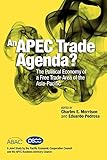An APEC Trade Agenda? : The Political Economy of a Free Trade Area of the Asia-Pacific / ed. by Charles E. Morrison, Eduardo Pedrosa.
Material type: TextPublisher: Singapore : ISEAS Publishing, [2007]Copyright date: ©2007Description: 1 online resource (264 p.)Content type:
TextPublisher: Singapore : ISEAS Publishing, [2007]Copyright date: ©2007Description: 1 online resource (264 p.)Content type: - 9789812304605
- 9789812304612
- 382.71095 22
- HF2294 .A64 2007
- online - DeGruyter
| Item type | Current library | Call number | URL | Status | Notes | Barcode | |
|---|---|---|---|---|---|---|---|
 eBook
eBook
|
Biblioteca "Angelicum" Pont. Univ. S.Tommaso d'Aquino Nuvola online | online - DeGruyter (Browse shelf(Opens below)) | Online access | Not for loan (Accesso limitato) | Accesso per gli utenti autorizzati / Access for authorized users | (dgr)9789812304612 |
Frontmatter -- Contents -- List of Tables -- List of Figures -- 1. An APEC Trade Agenda -- 2. A Free Trade Area of the Asia-Pacific in the Wake of the Faltering Doha Round: Trade Policy Alternatives for APEC -- 3. The Political Economy of a Free Trade Area of the Asia-Pacific: A U.S. Perspective -- 4. The Political Economy of a Free Trade Area of the Asia-Pacific: A China Perspective -- 5. Japan’s FTA Strategy and a Free Trade Area of the Asia-Pacific -- 6. Lessons from the Free Trade Area of the Americas for APEC Economies -- 7. Prospects for Linking Preferential Trade Agreements in the Asia-Pacific Region -- 8. ASEAN Perspective on Promoting Regional and Global Freer Trade -- The Contributors -- Index
restricted access online access with authorization star
http://purl.org/coar/access_right/c_16ec
The proposal for an Asia-Pacific–wide free trade agreement is one of the oldest ideas for promoting mutually beneficial regional cooperation dating back to the mid-1960s. In more recent times, the idea has found new support for two main reasons: as a plan B to the stumbling Doha Development Agenda (DDA) round of WTO negotiations; and as a solution to the noodle bowl of bilateral agreements in the region. This report assesses the political feasibility of the Free Trade Area of the Asia-Pacific (FTAAP) proposal and looks at alternative modalities for achieving free trade and investment in the Asia-Pacific. The report includes trade policy perspectives from the three largest economies of the region: the United States, China and Japan, lessons from similar proposals such as the Free Trade Area of the Americas (FTAA), possible convergence among the many preferential trade agreements (PTAs) in the region, and alternative approaches to regional economic integration.
Mode of access: Internet via World Wide Web.
In English.
Description based on online resource; title from PDF title page (publisher's Web site, viewed 01. Dez 2022)


